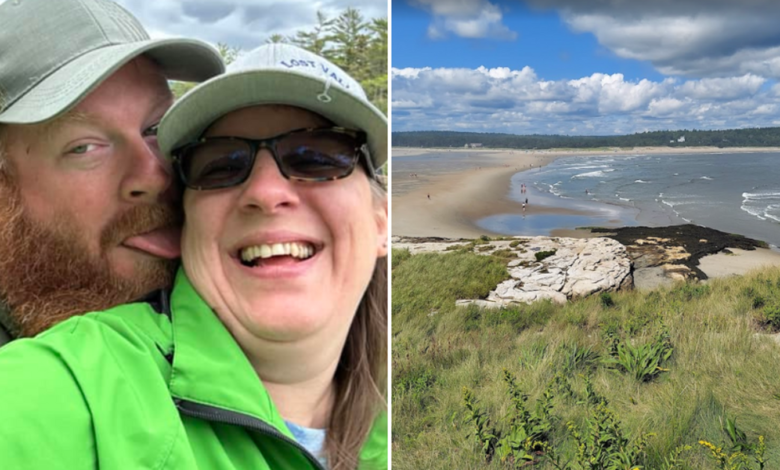7 Terrifying Facts About a Woman Swallowed by Quicksand: A Cautionary Adventure

Discover the gripping story of a woman swallowed by quicksand. This fascinating tale explores the dangers of quicksand, survival tips, and the lessons learned from this harrowing experience.
Introduction
A woman swallowed by quicksand is a story that captivates the imagination. Quicksand, often depicted in movies and books, is both mysterious and frightening. It lurks silently in marshes and riverbanks, ready to ensnare the unsuspecting. In this blog post, we will dive deep into the tale of one woman’s terrifying encounter. Through her experience, we will learn about quicksand, its dangers, and how to stay safe.
When we think about quicksand, we might picture a dramatic scene from a movie. However, quicksand is real and can be found in various places around the world. This blog will not only recount the woman’s story but also provide valuable information about quicksand. Additionally, we will explore the science behind it and offer tips for avoiding dangerous situations. Let’s embark on this journey together!
What is Quicksand?
Understanding Quicksand
Quicksand is a mixture of sand, water, and clay. When water saturates the sand, it creates a fluid-like substance that can trap anything that steps into it. As a result, the mixture loses its ability to support weight. Consequently, people or animals can become trapped and struggle to escape. This is the science behind why a woman swallowed by quicksand can happen so quickly.
Interestingly, quicksand can occur in various environments. It is often found near rivers, lakes, and coastal areas. Knowing where quicksand is likely to be found is essential for staying safe. Therefore, understanding the characteristics of quicksand can help prevent accidents.
The Dangers of Quicksand
The danger of quicksand lies in its deceptive appearance. It often looks like solid ground, luring people into a false sense of security. Once someone steps onto it, they may find themselves slowly sinking. Furthermore, panic can set in, making it even more challenging to escape. This fear is what makes the story of a woman swallowed by quicksand so gripping.
Moreover, quicksand can be dangerous not only due to sinking but also because it can occur in remote areas. If someone becomes trapped, help may not be readily available. This isolation can turn a frightening situation into a life-threatening one. Therefore, it is crucial to be aware of surroundings.
The Story of a Woman Swallowed by Quicksand
A Day of Adventure
On a sunny afternoon, a woman named Sarah decided to explore a nearby marsh. Excited about her adventure, she packed a small backpack with snacks and water. As she walked through the lush greenery, she felt a sense of freedom. However, little did she know that danger was lurking nearby.
While walking along the water’s edge, Sarah spotted what looked like solid ground. It appeared to be a small island in the marsh. Curiosity got the better of her, and she stepped onto the surface. At first, everything seemed fine. However, without warning, the ground beneath her feet began to give way. Before she knew it, Sarah was trapped in quicksand.
The Struggle for Survival
As Sarah sank deeper, panic set in. She struggled to keep her head above the surface. Each movement only made her sink faster. Thoughts raced through her mind, and she realized she needed to stay calm. Remembering advice she had heard, she tried to relax her body and remain still. This was her only chance for survival.
Fortunately, Sarah had her phone in her pocket. With great effort, she managed to reach for it and call for help. Her voice trembled as she explained her situation. Thankfully, her friends were nearby and quickly rushed to her aid. However, time was of the essence, and Sarah’s struggle continued.
How to Escape Quicksand
Stay Calm and Assess the Situation
If you ever find yourself in quicksand, the first step is to stay calm. Panic can cause you to move erratically, making the situation worse. Instead, take a moment to assess your surroundings. Look for anything that can help you, such as a branch or a friend nearby.
Additionally, try to remember the importance of slow, deliberate movements. This technique can help you float rather than sink. By shifting your weight slowly, you may be able to escape the quicksand’s grip. It is essential to think clearly during this frightening moment.
Call for Help
If possible, call for help. Your voice carries farther than you might think. Loudly shout for assistance, and make sure to provide your location. Friends or passersby may hear you and come to your rescue. Even in remote areas, there may be people nearby who can help.
Moreover, if you are unable to escape, try to make yourself as visible as possible. Wave your arms or use any bright clothing to attract attention. This visibility can be crucial in getting the help you need.
The Science Behind Quicksand
How Quicksand Forms
Quicksand forms when water saturates sand and creates a mixture that becomes unstable. This instability occurs due to the weight of the sand particles pressing down on one another. As a result, the sand can lose its grip, creating a fluid-like substance. This process is fascinating and dangerous.
Interestingly, quicksand can exist in various forms. Some quicksand is more liquid, while others can feel more solid. Understanding these differences can help individuals recognize potential hazards. Therefore, being aware of the type of quicksand can aid in avoiding dangerous situations.
The Role of Water
Water plays a crucial role in the formation of quicksand. When rain falls or rivers overflow, water can saturate the ground. This saturation can create pockets of quicksand that are difficult to detect. Moreover, the presence of water also contributes to the quicksand’s ability to trap objects.
Additionally, quicksand can change with the environment. For instance, dry conditions can reduce the amount of quicksand present. On the other hand, heavy rainfall can increase the likelihood of encountering quicksand. Understanding these changes can help individuals stay safe during outdoor activities.
Lessons Learned from the Experience
Awareness is Key
The story of a woman swallowed by quicksand teaches us important lessons about awareness. Being mindful of one’s surroundings is essential when exploring nature. Before stepping onto what appears to be solid ground, it is wise to assess the situation. Knowing where quicksand is likely to be found can prevent dangerous encounters.
Furthermore, sharing knowledge about quicksand can help others stay safe. By discussing the risks and how to avoid them, we can create a more informed community. This awareness can lead to safer adventures for everyone.
The Importance of Preparation
Preparation is another crucial lesson from Sarah’s experience. Carrying a phone or a whistle can make a significant difference in emergencies. Additionally, having a first-aid kit and telling someone your plans can enhance safety. These small steps can help ensure that you are ready for unexpected situations.
Moreover, learning about the environment before exploring can provide valuable insights. Understanding the terrain and potential hazards can lead to safer adventures. Ultimately, preparation can save lives.

Conclusion
The terrifying tale of a woman swallowed by quicksand serves as both a cautionary tale and a source of valuable lessons. Quicksand, while fascinating, is a dangerous phenomenon that requires respect and awareness. By understanding quicksand and its dangers, we can enjoy our adventures while staying safe.
In the end, Sarah’s story reminds us to remain calm in the face of danger and to seek help when needed. By learning from her experience, we can better prepare ourselves and those around us for the unexpected. So, the next time you venture into nature, remember to keep an eye out for quicksand and stay safe!
FAQs
1. What is quicksand?
Quicksand is a mixture of sand, water, and clay that can trap objects, including people. It forms when the ground becomes saturated with water, creating a semi-liquid state.
2. How does quicksand work?
When pressure is applied to quicksand, it can lose its strength and become unstable. This means that if a person steps into it, they may begin to sink as the sand shifts.
3. Is quicksand dangerous?
Yes, quicksand can be dangerous. It can trap a person, making it difficult to escape. However, most quicksand is not deep enough to completely submerge a person.
4. What should you do if you find yourself in quicksand?
If you find yourself in quicksand, try to stay calm. Move slowly and try to float on your back. This will help distribute your weight and make it easier to escape.
5. Can quicksand be found in urban areas?
Quicksand is more commonly found in natural settings, such as beaches and marshes. However, it can occasionally occur in urban areas, especially near construction sites or water bodies.
6. Are there any myths about quicksand?
Yes, many myths exist. One common myth is that quicksand can swallow a person whole. In reality, while it can trap someone, it usually does not engulf them completely.
7. How can you avoid quicksand?
To avoid quicksand, stay on established paths when hiking or exploring. Be cautious near water bodies and avoid soft, muddy areas.
8. What are some survival stories related to quicksand?
There are several survival stories where individuals have escaped quicksand, often by using techniques like remaining calm and slowly wiggling their legs to create space.
Feel free to ask if you have more questions or need further information!
READ MORE : Fascinating Facts About Liam Costner: The Rising Star in Hollywood




